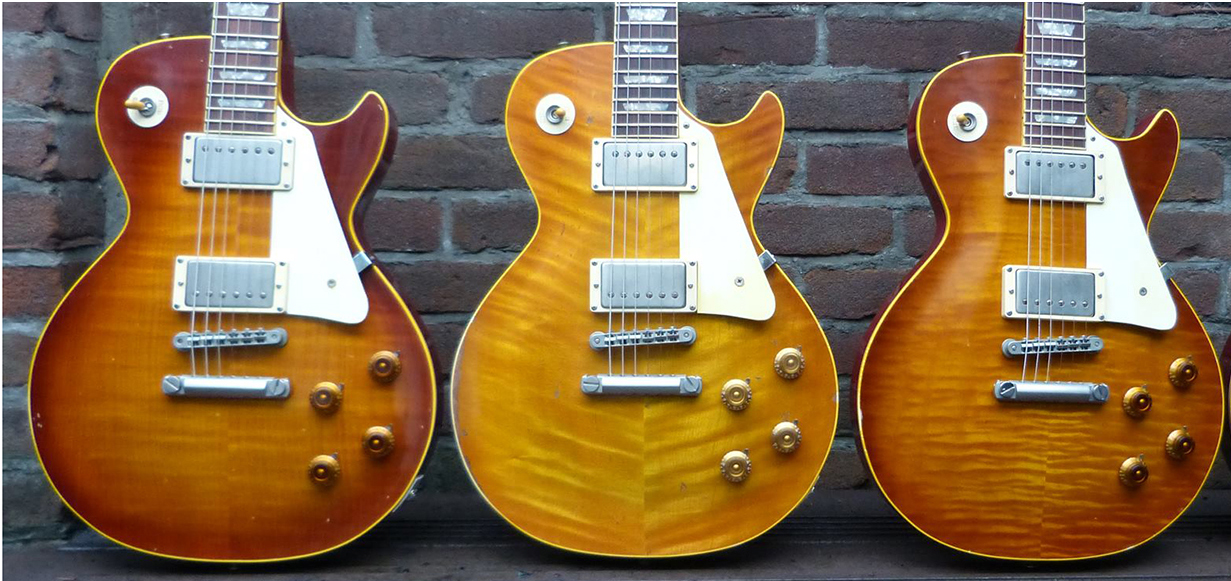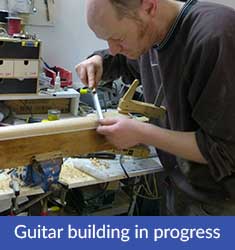In this early stage of the ’59 series, I need some thorough testing to get a good understanding of the sound and how they are appreciated. Especially because vintage guitars and the real ’59s (build between ’58 and ’60) sound a bit differently than the ones that are build today. My quest is to design a open sounding vintage voiced ’59, what some people call a “tele on steroid”. No muddy neck pickup, but open, bright and with articulation, great dynamics and string separation. What I call, thinner but broader. To find out if people recognized this in my ’59s, I organized a double blind test with eight very different players (from jazz to metal to vintage rock) who tested, scored and judged the guitars, purely on their ears and playability. Here a short impression of the results.

The three guitars that we tested different mainly in the magnets of the pickups. I have wound the pickups with the same amount of turns, but the magnets were different. Number C-003 has Alnico V rough cast for both pickups, Number C-004 has Alnico II for both pickups, and Number C-005 has Alnico IV in the bridge and Alnico III in the neck. To make sure that the potmeters didn’t influence the test, I made sure that every one of them was measured through for the same position. For the woods, C-004 has a body made of very light Spanish ceder, the other two bodies were made from Kaya mahogany. All three have big leave maple tops. All necks are hand shaped, roughly the same. Nevertheless, tiny differences can give them a different feel altogether.
Before talking about the test results, here brief indication of the magnets and how they are a supposed to sound*):
Alnico II – Creamy and round highs, strong and loose sounding mids, warm lows, and open dynamics. Low output.
Alnico III – Similar to Alnico 2 but with sweeter and more dynamic sounding highs, and clearer, more articulate lows. Lowest output.
Alnico IV– A good happy medium between Alnico 2 and Alnico 5 tonal characteristics, with a very natural sounding and flat EQ range. Medium/low output.
Alnico V– Tighter EQ with heavier punch and attack. Slightly less mid presence with stronger, and clearer dynamics on the lows and highs. Higher output.
First of all, blind testing is very hard to do. It all comes down to small distinctions, even more difficult to identify when someone else is playing, with an amp you don’t know, etc. etc. So my compliments to their fine listening. Some impression on the results and my conclusions based on what people were saying:
Number C-003: This one has clearly a bit more high in the top end. A bit more aggressive, a bit more ‘in your face’. Great at high gain.
Number C-004: The Alnico II was a bit more mellow than the Alnico V. Whereas in the acoustic test this guitar was much more bright and resonant than the other two. I believe that the light weight Spanish cedar, the total weight of the guitar is not even 3,2 kg unchambered, contributed to its great resonance.
Number C-005: The bridge pickup was well balanced, not jumping out in any frequency. The most vintage sounding of them all. It may explain why the expensive replicas of PAFs prefer the Alnico IV. The neck pickup was also very even and balanced. A little bit lower in output (because of the weakness of the magnet), but very articulate.
The test results are obviously a subjective impression. Many factors, such as the style of the player, the amp and more, all play a role. If the test results have anything to do with numbers, 50% of the players were most enthusiastic about C-005 (Al IV and Al III), blindly tested. There was a tie between the C-003 and C-002.
My lesson learned from these results, is that it confirms the well known statements about the magnets. The magnets make up most of the differences, and the wood perhaps not as much as most people claim. The light weight of the Spanish ceder, however, sounds acoustically so open and resonant. But electrically, again the pickups seem to make the tone. To me this is very helpful to guide people with their own quest and special wishes for the tone of their guitar. While I don’t disregard the influence of the wood, to my believe the pickups and your potmeters do much more for the sound than wood does in Electric guitars.**)
Notwithstanding the quality of a guitar, the most important factor of the tone generator in guitars or any musical instrument is and remains YOU!!!
Special thanks to the testers:
Dennis de Bruin
Peter Donkers (also for providing the testing room)
Peter van Dorst
Wladimir Eenkhoon (Tone Stack)
Ab van Gemonden
Wojtek Justyna
Will Sophie
Edwin Velsink
Paul Wesselink
Here a brief impression of the jam, after the testing was done:
*) Source: MojoTone
**) To learn more about the different sound qualities of woods in acoustic guitars, take a look at the very interesting Leonardo project.





